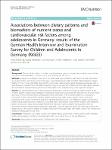Associations between dietary patterns and biomarkers of nutrient status and cardiovascular risk factors among adolescents in Germany: results of the German Health Interview and Examination Survey for Children and Adolescents in Germany (KiGGS)
Richter, Almut
Rabenberg, Martina
Truthmann, Julia
Heidemann, Christin
Roosen, Jutta
Thiele, Silke
Mensink, Gert
Background: The aim of this study is to analyse prevailing dietary patterns among German adolescents and their associations with biomarkers of nutrient status and cardiovascular risk factors. Methods: Analyses were based on data from the nationwide, representative Health Interview and Examination Survey for Children and Adolescents in Germany, conducted between 2003 and 2006 (KiGGS baseline). Dietary habits of 12 to 17 year olds (2646 boys and 2551 girls) were determined using 34 food groups assessed with a food frequency questionnaire. Principal component analysis was applied to determine the major dietary patterns. The associations between dietary patterns and biomarkers were analysed using linear regression analyses. Results: We identified three major dietary patterns among boys and two among girls. Higher scores of the ‘healthy’ patterns (fruits, salad vegetables, wholemeal bread) were associated with higher levels of serum folate and lower levels of homocysteine among both sexes and higher levels of serum vitamin B12 among girls. Conversely, higher scores of the ‘western’ pattern among boys (salty snacks, burger, French fries) were associated with a lower ferritin level and lower diastolic blood pressure. The ‘traditional’ pattern among boys (white bread, processed meat, meat) was associated with a lower folate level and the ‘western and traditional’ pattern among girls (salty snacks, burger, French fries) with lower folate and higher homocysteine levels. No associations between dietary patterns and blood lipids, HbA1c and uric acid were found. The mean age of boys with higher scores in the ‘western’ pattern was higher, whereas the mean age of girls with higher scores in the ‘western and traditional’ dietary patterns was lower. Conclusions: Adolescents with higher scores in the ‘healthy’ dietary patterns had a better nutrient profile. Therefore, healthy dietary patterns should be promoted early in life, with a special focus on the sex differences.
Dateien zu dieser Publikation
Keine Lizenzangabe

